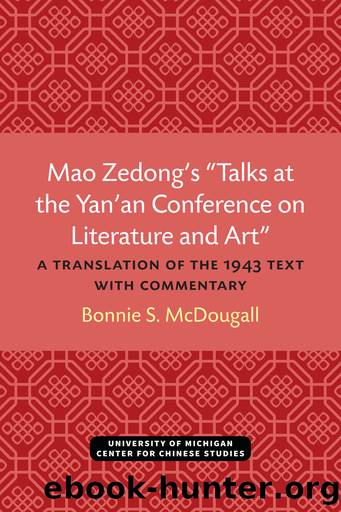Mao Zedongâs âTalks at the Yanâan Conference on Literature and Artâ: A Translation of the 1943 Text with Commentary by Bonnie S. McDougall

Author:Bonnie S. McDougall
Language: eng
Format: epub
Publisher: Kenneth G. Lieberthal and Richard H. Rogel Center for Chinese Studies
Published: 2020-01-15T00:00:00+00:00
âTalks at the Yanâan Conference on Literature and Artâ*
Mao Zedong
Translatorâs note: I have retained the original number of sentences from Maoâs text. Punctuation within sentences, however, has been changed to conform to standard American usage.
October 19 is the seventh anniversary of the death of Lu Xun. We have specially published Comrade Mao Zedongâs talks at the Yanâan conference on literature and art to commemorate the greatest and most heroic standard-bearer of the Chinese cultural revolution.
Peopleâs Daily editor, 1943
INTRODUCTION*
(2 May 1942)
Comrades! I have invited you to this conference today for the purpose of exchanging opinions with you on the correct relationship1 between work in literature and art and revolutionary work in general, to obtain the correct development of revolutionary literature and art and better assistance from them in our other revolutionary work, so that we may overthrow our national enemy and accomplish our task of national liberation.2
There are a number of different fronts in our struggle for the national liberation of China, civil and military, or, we might say, there is a cultural as well as an armed front. Victory over the enemy depends primarily on armies with guns in their hands, but this kind of army alone is not enough. We still need a cultural army, since this kind of army is indispensable in achieving unity among ourselves and winning victory over the enemy. Since May Fourth, when this cultural army took shape in China, it has aided the Chinese revolution by gradually limiting the sphere of Chinaâs feudal culture and the slavish culture3 that serves imperialist aggression, and weakening their strength, so that now reactionaries are reduced to resisting new culture by âmeeting quality with quantityâ: reactionaries arenât short of money, and with some effort they can turn out a lot even if they canât come up with anything worthwhile. Literature and art have formed an important and successful part of the cultural front since May Fourth. The revolutionary movement in literature and art, which developed considerably during the Civil War period, had the same general direction as the Red Army struggles4 of that time, but there was no coordination between them in their actual work and each fought as an independent army.5 The reason was that the reactionaries at that time kept the two fraternal armies apart. After the War of Resistance against Japan broke out, the number of workers in the field of revolutionary literature and art who came to Yanâan and other anti-Japanese bases increased, which was very good. However, coining to a base area is by no means the same thing as integrating with the peopleâs movement6 there, and if we want to push ahead with our revolutionary work, we must integrate these two forces completely. Our meeting today is to ensure that literature and art become a component part of the whole revolutionary machinery, so they can act as a powerful weapon in uniting and educating the people while attacking and annihilating the enemy, and help the people achieve solidarity in their struggle against the enemy.
Download
This site does not store any files on its server. We only index and link to content provided by other sites. Please contact the content providers to delete copyright contents if any and email us, we'll remove relevant links or contents immediately.
What's Done in Darkness by Kayla Perrin(25507)
Shot Through the Heart: DI Grace Fisher 2 by Isabelle Grey(18227)
Shot Through the Heart by Mercy Celeste(18168)
The Fifty Shades Trilogy & Grey by E L James(17783)
The 3rd Cycle of the Betrayed Series Collection: Extremely Controversial Historical Thrillers (Betrayed Series Boxed set) by McCray Carolyn(13196)
The Subtle Art of Not Giving a F*ck by Mark Manson(12923)
Scorched Earth by Nick Kyme(11843)
Stepbrother Stories 2 - 21 Taboo Story Collection (Brother Sister Stepbrother Stepsister Taboo Pseudo Incest Family Virgin Creampie Pregnant Forced Pregnancy Breeding) by Roxi Harding(11061)
Drei Generationen auf dem Jakobsweg by Stein Pia(10223)
Suna by Ziefle Pia(10188)
Scythe by Neal Shusterman(9270)
International Relations from the Global South; Worlds of Difference; First Edition by Arlene B. Tickner & Karen Smith(8624)
Successful Proposal Strategies for Small Businesses: Using Knowledge Management ot Win Govenment, Private Sector, and International Contracts 3rd Edition by Robert Frey(8426)
This is Going to Hurt by Adam Kay(7713)
Dirty Filthy Fix: A Fixed Trilogy Novella by Laurelin Paige(6459)
He Loves Me...KNOT by RC Boldt(5809)
How to Make Love to a Negro Without Getting Tired by Dany LaFerrière(5387)
Interdimensional Brothel by F4U(5312)
Thankful For Her by Alexa Riley(5174)
